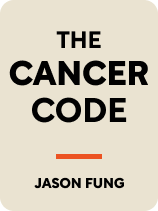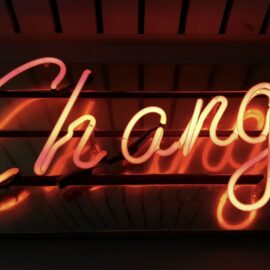

This article is an excerpt from the Shortform book guide to "The Cancer Code" by Jason Fung. Shortform has the world's best summaries and analyses of books you should be reading.
Like this article? Sign up for a free trial here.
What is Jason Fung’s The Cancer Code about? What is the key message to take away from the book?
Published in 2020, The Cancer Code by Jason Fung is one of the most up-to-date and comprehensive books on this topic. It provides an overview of scientists’ major discoveries about cancer, starting from ancient times and continuing to the present day.
Below is a brief overview of The Cancer Code by Jason Fung.
The Cancer Code: A Revolutionary New Understanding of a Medical Mystery
In The Cancer Code, Jason Fung breaks down the history of cancer research into three paradigms, which this guide will refer to as Models for simplicity’s sake. These Models are different ways scientists of the time understood cancer: why it occurred, how it progressed, and how it could be treated. Fung explores each of the three Models, their strengths and shortcomings, and their implications for treating cancer. In doing so, he also explains why curing cancer was nearly impossible until the last century or so, and why new discoveries provide hope for more reliable and safer treatment options in the future.
Fung is a nephrologist specializing in nutrition science and metabolic diseases. As such, he brings a unique perspective to the fight against cancer. He puts special emphasis on how cancer uses our natural bodily functions to grow and spread, as well as how we can adjust our lifestyles to reduce our chances of developing it.
In this guide, our commentary will expand on some of Fung’s key ideas, offer counterpoints to others, and suggest some other books for further reading on this complex topic. We’ll also examine the current effectiveness of a number of cancer treatment methods and what recent discoveries might imply about future treatment options.
Model 1: Cancer as Uncontrolled Growth
In order to treat cancer, scientists first had to answer the question: What is cancer? In other words, they needed to figure out what was going wrong with patients’ bodies so that they could determine how to fix the problems.
Fung says that scientists’ earliest understanding of cancer—dating at least back to Ancient Egypt—was simply a description of its symptoms, most notably the tumors that form in patients’ bodies. As such, many scientists developed an understanding of cancer as an abnormal growth that would eventually kill its victim. Others believed that cancer was caused by an imbalance of black “bile” in the body.
Working from this very early and incomplete model, it seemed like cancer should be treated by destroying or removing the tumors. However, as Fung points out, a simple description of cancer’s symptoms didn’t address how or why those tumors formed, so doctors’ attempts at treatment almost invariably failed. Indeed, up until the last 100 years or so, medical texts all agreed that cancer was incurable.
What Is Cancer, Really?
This early understanding of cancer merely as a harmful tumor was woefully incomplete. Thanks to decades of dedicated research, we now have a much better understanding of what cancer is and how it works.
Fung tells us that cancer is not a single disease, but rather a type of disease. Almost every cell in the body has the potential to turn cancerous, and each cancer will be different depending on where it’s located and what type of cells are affected. However, all cancers have some things in common:
Rapid, endless cell division. Cancer cells divide quickly and ignore the chemical signals that normally cause that process to stop. Furthermore, while there is normally a limit to how many times a particular cell can divide, cancer cells can keep doing so forever. This is because cells contain structures called telomeres at the ends of their chromosomes; normally, telomeres shorten each time a cell divides, and the cell undergoes apoptosis (cell death) once the telomeres become too short. However, cancer cells use an enzyme called telomerase to rebuild them, meaning the malignant cells are functionally immortal.
Metastasis and invasion. Cancerous cells break away from the primary tumor and travel throughout the body, creating secondary tumors in other locations. Fung says that this process, called “metastasis,” is what separates benign tumors from malignant ones and what makes cancer so dangerous. A benign tumor can grow to enormous size without causing much harm to the patient, but a metastatic tumor—one that sheds cells into different types of tissue where those cells don’t belong—is deadly.
Co-opting nutrients and energy. Cancerous tumors induce nearby blood vessels to grow throughout the tumor, a process called angiogenesis, thereby providing the malignant cells with oxygen and other nutrients. Also, cancer cells usually use a fast but inefficient method of producing energy, meaning that they use up much more glucose (sugar) than ordinary cells.
In short, cancer is a type of disease where your own cells parasitize your body. Malignant cells grow, divide, and spread, fueling themselves by consuming enormous amounts of energy and nutrients, all while evading your natural defenses.
Model 2: Cancer as the Result of Genetic Mutations
Early doctors’ concept of cancer as simply a harmful tumor wasn’t enough for them to truly understand or treat it. Fung tells us that it took until the 1900s—when scientists began exploring the field of genetics in earnest—to develop a more accurate model of cancer.
This new model, which we’re calling Model 2, described cancer not merely as a growth but also as the result of harmful mutations in a cell’s DNA. Those mutations caused normal processes, such as energy production and cell division, to run wild.
In short, Model 1 described cancer’s symptoms, while Model 2 described its mechanisms: the biological processes behind the disease. By learning how malignant cells functioned, scientists believed that they would be able to develop treatments that disrupted those functions, thereby curing the disease.
The Somatic Mutation Theory of Cancer
Fung says that Model 2 is based on the idea of somatic mutations: changes in the DNA of somatic cells, which are any cells other than gametes (sperm and eggs). The fact that these mutations don’t affect gametes is important because it means cancer can’t be inherited—for example, a person with lung cancer won’t produce a child with lung cancer.
German biologist Theodor Boveri developed an early version of this theory in his book The Origin of Malignant Tumors, published in 1914. In this book, Boveri observed that the human body must have mechanisms both to promote cell growth and to restrict it. Without such mechanisms, numerous normal processes would be impossible—for example, growing from a child to an adult and having that growth stop once you reach maturity. Therefore, Boveri reasoned, mutations to the genes that control cell growth could cause malignant tumors to form.
Cancer researchers in the 1970s discovered several genes like those Boveri had hypothesized, and many more have been found since. Cancer almost always involves mutations to these growth-promoting genes (now called oncogenes) and growth-restricting genes (called tumor suppressor genes). In short, malignant tumors form because mutated oncogenes promote growth too much, and mutated tumor suppressor genes are unable to prevent that growth.
Environmental Factors: Carcinogens
A key point of the somatic mutation theory is that cancer can’t be directly passed down to offspring (although various genes do make certain types of cancer more likely). But if bad genes don’t cause cancer, what does? Fung tells us that cancer is almost always the result of environmental factors called carcinogens—literally, “tumor creators.”
The list of known carcinogens is enormous and constantly growing. Some of the best-known carcinogens include tobacco, asbestos, and radiation (such as x-rays or UV radiation from the sun). Others include soot and wood dust, certain drugs, and even some pathogens such as the Rous sarcoma virus and human papillomavirus (HPV). The common thread between all of these carcinogens is that they damage or destroy cells. Sometimes the body fixes that damage incorrectly, causing slight changes in the genetic material—in other words, mutations.
Many of these mutations are harmless, and your body’s natural defenses usually identify and destroy any mutations that arise. However, over time and with repeated damage to the cells, it becomes more likely that at least one of those mutated cells will turn cancerous. In short, every time the body has to repair itself (for any reason), there’s a very small chance that those repairs will produce malignant cells.
The good news, according to Fung, is that knowledge of carcinogens is the best weapon we have in the fight against cancer, as well as the easiest one to use. After all, it hardly matters what specific cancer-causing mutations UV radiation produces, or how to treat the disease those mutations cause, if we just wear sunscreen to make sure that damage doesn’t happen in the first place.
Fatal Flaws of Model 2
Fung says that Model 2, while technically accurate, still fails to explain what cancer really is. It’s like trying to understand how a tree grows by cataloging every leaf on it—we’d learn a lot about individual leaves, but very little about how and why the tree itself grows. More to the point of cancer research, we wouldn’t learn anything about how to stop or reverse the tree’s growth.
Indeed, despite scientists mapping hundreds of cancer genomes, finding countless cancer-related mutations, and promising personalized treatment that targeted each patient’s specific form of cancer, a 2018 study found that less than five percent of cancer patients benefited from treatments targeting specific mutations. In other words, decades of research and billions of dollars in funding had failed to produce results.
In addition to failing as a basis for treatment, Fung says that Model 2 also fails as an explanation of cancer. The somatic mutation theory can’t explain why cancer is so common, or why there are so many different types of cancer that all share the same characteristics.
The odds of numerous specific mutations—uncontrolled growth, hiding from the immune system, leeching the body’s nutrients, and so on—all arising in a single cell are incredibly low. Therefore, random chance can’t explain why cancer is so prevalent among modern-day humans.
Model 3: Cancer as an Evolving Species
Having dismissed both of the previous models, Fung presents a newer hypothesis. Model 3 was not proposed by a biologist, but by physicist Paul Davies, whom the National Cancer Institute reached out to in 2009 in the hope that an outsider’s viewpoint could provide some new insights about cancer.
Model 3 suggests that cancer is an atavism: an evolutionary throwback in which ancestral traits reemerge in modern organisms. In this case, Davies proposed that cancer is the re-emergence of traits from the earliest single-celled organisms, caused by evolutionary pressure from carcinogens. (We’ll explain this evolutionary pressure in more detail later.)
In short, Model 1 described what cancer is, Model 2 described how it works, and now Model 3 offers a theory about why it happens.
Support for Model 3
To support this idea of cancer-as-atavism, Fung points out that cancer cells act like simple organisms: They grow, feed, reproduce, and evolve. Therefore, rather than Model 2’s concept of random mutations causing cells to run wild, this hypothesis says that cancer’s behavior is actually extremely logical and focused on survival; not the survival of the host, but of the cancerous “organism.”
Atavism explains why cancer can be found in nearly every animal species on Earth: It’s because the traits of cancer come from our oldest common ancestors. Furthermore, there’s genetic evidence for this theory in addition to the behavioral evidence—mutations in cancerous cells are most likely to affect those genes that evolved shortly after the first multicellular organisms emerged, effectively reverting them to the genes of single-celled organisms.
In other words, malignant cells didn’t need to evolve cancerous traits from scratch, because the genes for the traits were already in their DNA. The cells just needed to evolve (or devolve) in such a way that those genes reactivated.
How Model 3 Fixes Model 2
Fung says that this model of cancer as an evolving species solves the two major shortcomings of the somatic mutation theory. First, cancer does not spring up at random—the elements of cancer are already present in our DNA, so all the cell needs to become malignant is for those genes to reactivate. This provides a much more satisfactory answer to cancer’s prevalence than random chance could.
Second, Model 3 reveals that genetically-targeted treatments are mostly ineffective because of cancer’s genetic variation. After turning cancerous, cells continue to divide and mutate extremely quickly, meaning that even cancerous cells within a single patient can have countless different genetic traits. So, while a targeted treatment will kill many of the malignant cells, it’s very likely that some will be resistant to it. Even worse, those surviving cells will continue to reproduce, meaning that cancer can evolve to resist any given treatment.
Therefore, to cure a patient and avoid relapse, doctors must either find and target the root mutation—the original genetic change that all the cancer cells share—or use a battery of different treatments to ensure that every malignant cell is destroyed.
How Model 3 Describes the Progression of Cancer
Using this new model of cancer as a separate species, Fung describes how the disease progresses in three phases:
Phase 1: Carcinogens Drive Cellular Evolution
We mentioned before that there are countless known carcinogens, and that carcinogens cause damage that the body sometimes repairs incorrectly. However, Fung says that viewing cancer as an evolving species provides a more complete explanation of how carcinogens work: carcinogens create evolutionary pressure at the cellular level.
Every known carcinogen causes some kind of damage—the sun damages your skin, tobacco smoke damages your lungs, and so on. The damage isn’t serious enough to kill every cell the carcinogen reaches, but it does kill some of them, leaving the surviving cells to reproduce. The cells most likely to survive are those with the traits of cancer: rapid reproduction, the ability to ignore signals that trigger cell death, the ability to co-opt the body’s resources for their own survival, and so on.
In short, cells evolve cancerous traits because they’re very effective survival mechanisms.
Phase 2: Growth Factors Drive Cellular Reproduction
Growth factors are naturally-occurring chemicals and proteins that, as the name suggests, stimulate cell growth and cell division. Every multicellular organism needs growth factors; however, since rapid cell growth is the primary hallmark of cancer, growth factors create an ideal environment for cancerous cells to flourish. More cells also mean more mutations—more genetic diversity—which helps to prepare the cancerous “species” for the next step in its evolution.
The body’s growth factors are controlled by nutrient sensors that detect the presence or absence of various nutrients in the body. When nutrients are plentiful, the growth factors activate; when nutrients are scarce, the growth factors deactivate so the body can focus on conserving energy and culling damaged cells.
According to Fung, growth factors and nutrient sensors explain why cancer is so much more prevalent in Western countries: Our diets contain a lot of processed foods with easily-accessible nutrients, meaning those growth factors are almost always active. As a result, our bodies create cells more rapidly and destroy mutated cells more slowly than usual.
With this in mind, Fung suggests that reducing our consumption of processed foods and intermittent fasting can help to prevent cancer by reducing growth factor activity. He puts particular emphasis on controlling our insulin levels; eating a lot of simple sugars causes the body to produce a lot of insulin, which acts as a growth factor and increases the likelihood of cancer.
Phase 3: Metastasis Drives Further Evolution
As a cancerous tumor grows, it also metastasizes. This means that the tumor sheds cells into the blood, where they are carried to different parts of the body. Those cells invade tissue in other places and give rise to new, secondary tumors.
However, Fung says that the process of metastasis is more complicated than many people think. The cells shed by the primary tumor face enormous evolutionary pressures: First of all, the immune system will find and destroy most of these cells while they’re still in the blood. Then, those few that can evade the immune system are still unlikely to survive—for example, a cancer cell that evolved in the liver wouldn’t be well suited to grow in the stomach.
Therefore, rather than simply spreading out from the primary tumor, metastasis can be a circular process. Malignant cells—further evolved from the evolutionary pressures they faced while traveling through the body—sometimes return to that first tumor and reattach to it in a process called tumor self-seeding. Now, these new cells must compete with the original cancer for resources; only the cells that reproduce most quickly and invade other tissues most effectively will survive.
Over numerous cycles, this process eventually gives rise to cells that are strong and aggressive enough to survive in other parts of the body, and those are the cells that go on to form secondary tumors. In other words, cancer doesn’t just fight against the body’s defenses; it’s in constant competition with itself to produce the hardiest and most virulent organisms possible.
Treatments Based on Model 3
Fung says that this new understanding of cancer—as an independent, evolving species—may represent a turning point in the fight against it. With a better understanding of how cancer operates and how the body fights against it, there is hope for more effective treatments with fewer side effects.
One promising option is immunotherapy: activating and strengthening the patient’s natural immune response. Fung points out that cancer doesn’t simply overwhelm our body’s defenses like a deadly infection does; instead, it evolves methods to hide from those defenses.
Therefore, forcibly activating the immune system and teaching it to target cancer cells—essentially, giving the patient a “cancer vaccine”—is highly effective. Furthermore, regardless of how the malignant cells continue to mutate, the immune system will still recognize them as foreign and destroy them.
Another strategy Fung discusses is adaptive therapy, developed by oncologist Robert Gatenby. Adaptive therapy uses standard chemotherapy treatments, but it aims only to keep the cancer at a manageable level instead of wiping it out entirely. This goes against the currently accepted practice of subjecting cancer patients to the strongest doses of drugs and radiation that they can withstand.
Gatenby’s reasoning is that the usual approach to chemotherapy creates extremely strong evolutionary pressure; if any malignant cells survive, they’re sure to be the ones most resistant to treatment, and those cells then pass their resistance on to a whole new generation of cancer.
Therefore, he believes that lower, less frequent doses of chemotherapy will be more reliable in the long run—there will be less pressure for the cancer cells to develop resistance to the treatment. Furthermore, drug resistance is costly in evolutionary terms; in the absence of those drugs, the cells without such resistances will be more successful. In this way, adaptive therapy seeks to turn cancer against itself by allowing the non-resistant cells to outcompete the resistant ones, then introducing another round of chemotherapy to beat them back.
While cancer is unlikely to be eliminated completely by such a strategy, Gatenby hopes that it will keep the disease stuck at an easily-managed level. This could allow more cancer patients to live longer and more normal lives than current chemotherapy methods provide.
These methods represent a major change from previous strategies, which unknowingly played to cancer’s greatest strengths: reproduction and evolution. Currently, the favored strategy is to simply blast away at the disease with toxic drugs and radiation until nothing remains, but even this approach requires doctors to overcome cancer’s constant replication and mutation—not to mention the devastating side effects the treatment regimen has on the patient.
Fung believes that, with this new model of cancer as an evolving species, there is hope for the future of cancer treatment. He acknowledges humanity still has a long fight ahead of it, but he says we’ve started gaining ground in that fight for the first time.

———End of Preview———
Like what you just read? Read the rest of the world's best book summary and analysis of Jason Fung's "The Cancer Code" at Shortform.
Here's what you'll find in our full The Cancer Code summary:
- A guide on what cancer is and how it works
- A deep dive into the three different models of cancer
- Why there is hope for the future of cancer treatments






